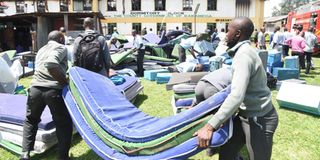Schools need to implement emergency evacuation plans

Students of Musingu High School in Kakamega county salvage their personal belongings after a dormitory caught fire on October 14, 2020.
As soon as I saw the disconcerting video of girls jumping out of a burning dormitory, I got onto my alumni WhatsApp group and asked: “Did we have fire escapes in school?”
Because personally, I didn’t remember having any fire escapes. I remember one time, having a fire drill, where all the girls in all the houses would leave the houses and assemble on the lawn in front of the houses, and do a headcount.
But I don’t remember any other ones after that; I don’t remember being told what to do or where to go during a fire in the dorms or during school hours; I don’t remember being told where a fire extinguisher was, or anything like that. We may have had buckets of sand placed at various locations, but nothing comes immediately to mind.
In fact, what stands out about that one fire drill is that our seniors had short-sheeted us – if that was even the same night – to scare us even more (short sheeting is when someone makes your bed but folds the sheet you enter into over so that you can’t put your legs in all the way through, and in some cases, you rip it).
Schools are not doing enough for these young girls, for these young children, to survive serious emergencies, like the fires we keep seeing reported. There have been quite a few fires, even during the pandemic. We’ve seen that schools are not doing enough before, and we continue to see it again. Then we discuss it and do nothing.
Most boarding schools, including my former one, insist on locking the children in dorms for safety after bedtime. In actuality, that’s extremely unsafe. We were even locked in the dining halls during mealtimes. And the worst part is, the people who had the keys to the dining halls and dorms (the matrons) moved far too slowly to stop potential tragedies.
What hit home for me even more concerning the Buruburu Girls incident, is how callously that video was shared in the media, and how unbothered the principal seemed to be when she tried to trivialise the few girls who were hurt, and repeat that the fire was only in one area. Tell that to the girls who were jumping from their windows, fearing for their very lives.
Our ‘authority figures’ have a terrible habit of minimising the effects that traumatic events have on people - remember the reaction to the fake Strathmore University fire drill (why was that drill even allowed to happen)? Perhaps it is because in their school years, their traumas were minimized as well, and so they feel a sense of ‘If I went through it and survived, you must too.’
All this is to say, that a large number of the high schools we entrust our children, our siblings, our nieces and nephews to, are not safe for these kids. Most don’t have fire drills often, and don’t have easily accessible ways out of buildings that aren’t locked every night to flee from the scene if need be. Many are unaware of the protocol involved when situations like this occur, and on top of that, many don’t care. And on a larger scale, outside of fires, lack of preparation often meets obstinate archaic administration.
When the fire at St. Georges Secondary happened, I remember parents were not even allowed to take their children home for safekeeping – seeing as the school clearly could not safekeep anyone. When rapes were happening at Moi Girls, the school continued to ignore the fact that that scraggly fence that surrounded the premises left the girls’ security to the wind. I am not sure if that fence has been fixed to date.
Where does that leave us? We all know someone in school, whether boarding or day. Fires, attacks, assaults, happen all the time. As alumni associations, as parents, as friends, as our sisters’ keepers, what are we doing to stop these administrations from ruining more lives?





